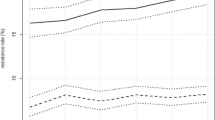Abstract
Estimating whether the individual probability of being infected by a fluoroquinolone resistant isolate is higher than 10% may help to choose the empirical treatment of pyelonephritis. We aimed to model the risk of fluoroquinolone resistance in women with community-onset pyelonephritis. Women with non-severe community-onset pyelonephritis were prospectively recruited in 4 French emergency departments of 2 districts. Adjusted odds ratios (aOR) and 95% confidence intervals were estimated through multivariate logistic regression. Among 190 patients, 19 (10%) were infected by a fluoroquinolone resistant isolate. Fluoroquinolone resistance was more frequent in district #2 (17%) than in district #1 (3%). Independent risk factors for fluoroquinolone resistance were district (adjusted OR, 7.0 (2.2–31.9)), and in the 6 previous months, urinary tract infection (UTI, aOR, 3.9 (1.3–11.5)) and vesical catheterization (aOR, 4.7 (0.5–33.3)). A specific model was derived to identify district #2 patients with a low (10% or lower) probability of being infected by a fluoroquinolone resistant isolate. Independent risk factors were residency in long-term care facility (aOR, 3.3 (0.7–13.5)), and in the 6 previous months, UTI (adjusted OR, 3.1 (0.9–10.7)) and home nursing care (aOR, 3.4 (0.6–17.0)). For 63 (67%) patients, the predicted probability of fluoroquinolone resistance was 0.10; among these patients, 6 (10%) actually had a fluoroquinolone resistant isolate. Locally derived predictive models may be used to identify patients with a low probability of fluoroquinolone resistance and guide the empirical antimicrobial therapy of non-severe community-onset pyelonephritis.
Similar content being viewed by others
References
Gupta K, Hooton TM, Naber KG, Wullt B, Colgan R, Miller LG et al (2011) International clinical practice guidelines for the treatment of acute uncomplicated cystitis and pyelonephritis in women: a 2010 update by the Infectious Diseases Society of America and the European Society for Microbiology and Infectious Diseases. Clin Infect Dis 52:e103–e120. https://doi.org/10.1093/cid/ciq257
Quaegebeur A, Brunard L, Javaudin F, Vibet M-A, Bemer P, Le Bastard Q et al (2019) Trends and prediction of antimicrobial susceptibility in urinary bacteria isolated in European emergency departments: the EuroUTI 2010–2016 study. J Antimicrob Chemother 74:3069–3076. https://doi.org/10.1093/jac/dkz274
Yelin I, Snitser O, Novich G, Katz R, Tal O, Parizade M et al (2019) Personal clinical history predicts antibiotic resistance of urinary tract infections. Nat Med 25:1143–1152. https://doi.org/10.1038/s41591-019-0503-6
Steyerberg EW, Vergouwe Y (2014) Towards better clinical prediction models: seven steps for development and an ABCD for validation. Eur Heart J 35:1925–1931. https://doi.org/10.1093/eurheartj/ehu207
Batard E, Vibet M-A, Lemarchand C, Navas D, Lepelletier D, Potel G et al (2017) Use of broad-spectrum antibiotics in French EDs: different trends for third-generation cephalosporins and fluoroquinolones. Eur J Emerg Med 24:189–195. https://doi.org/10.1097/MEJ.0000000000000331
Batard E, Lecadet N, Goffinet N, Hardouin JB, Lepelletier D, Potel G et al (2015) High variability among Emergency Departments in 3rd-generation cephalosporins and fluoroquinolones use for community-acquired pneumonia. Infection 43:681–689. https://doi.org/10.1007/s15010-015-0793-7
Gennai S, Ortiz S, Boussat B, François P, Pavese P (2018) Evaluation of ceftriaxone prescriptions in the emergency department of a university hospital: an urgent need for improvement and alternative therapy. Eur J Clin Microbiol Infect Dis 37:2063–2068. https://doi.org/10.1007/s10096-018-3339-y
Kim B, Myung R, Lee M-J, Kim J, Pai H (2019) Trend of antibiotics usage for acute pyelonephritis in Korea based on national health insurance data 2010–2014. BMC Infect Dis 19:554. https://doi.org/10.1186/s12879-019-4191-0
Soucy J, Schmidt AM, Quach C, Buckeridge DL (2019) Fluoroquinolone use and seasonal patterns of ciprofloxacin resistance in community-acquired urinary Escherichia coli in a large urban center. Am J Epidemiol. https://doi.org/10.1093/aje/kwz239
Sun L, Klein EY, Laxminarayan R (2012) Seasonality and temporal correlation between community antibiotic use and resistance in the United States. Clin Infect Dis 55:687–694. https://doi.org/10.1093/cid/cis509
Author information
Authors and Affiliations
Corresponding author
Ethics declarations
Conflict of interest
The authors declare that they have no conflict of interest.
Ethical approval
According to the French law, patients received written information and gave oral consent to participate. All procedures were in accordance with the ethical standards of the institutional and/or national research committee and with the 1964 Helsinki Declaration and its later amendments or comparable ethical standards.
Additional information
Publisher’s note
Springer Nature remains neutral with regard to jurisdictional claims in published maps and institutional affiliations.
Rights and permissions
About this article
Cite this article
Leforestier, A., Vibet, MA., Gentet, N. et al. Modeling the risk of fluoroquinolone resistance in non-severe community-onset pyelonephritis. Eur J Clin Microbiol Infect Dis 39, 1123–1127 (2020). https://doi.org/10.1007/s10096-020-03830-x
Received:
Accepted:
Published:
Issue Date:
DOI: https://doi.org/10.1007/s10096-020-03830-x




